Stargazers will be treated to the final supermoon of the year this evening, known as the Beaver Moon. The peak of this celestial event is expected to occur on Friday, Nov. 15 at 4:29 p.m. EST, as reported by NASA. If you’re interested in specific moonrise times for your area, the Old Farmer’s Almanac provides this information based on ZIP codes across the U.S.
During this special supermoon, the moon will be about 224,385 miles away from Earth. But why is it called the Beaver Moon? According to the Old Farmer’s Almanac, this name comes from the time of year when beavers retreat to their lodges after gathering food supplies for the winter. Native American tribes have other names for November’s full moon, such as Frost Moon, Freezing Moon, Digging Moon, Deer Rutting Moon, and Algonquin Whitefish Moon.
In 2024, there have been three other consecutive supermoons leading up to the Beaver Moon. The first one in August was a rare Supermoon Blue Moon called the Sturgeon Moon. September’s supermoon was the Super Harvest Moon, which included a partial lunar eclipse. October saw the Super Hunter’s Moon, the closest full supermoon of the year.
Looking ahead to 2025, there will be three supermoons. The first one is scheduled for October 7, followed by another on November 5, and the final one on December 4.
For those interested in viewing a supermoon, here are some tips:
– Timing matters: The supermoon looks most impressive during moonrise or moonset when it’s close to the horizon.
– Escape light pollution: To get a better view, consider going outside city limits to avoid artificial light interference.
– No special equipment required: The supermoon can be seen with the naked eye, but binoculars or a telescope can provide a more detailed look.
– Frame the view: When the moon is low on the horizon and framed by landmarks, it creates an optical illusion that makes it appear even larger.
So, if you’re eager to witness the magic of the Beaver Moon tonight, make sure to keep an eye out for the peak at 4:29 p.m. EST and enjoy this spectacular lunar event!


